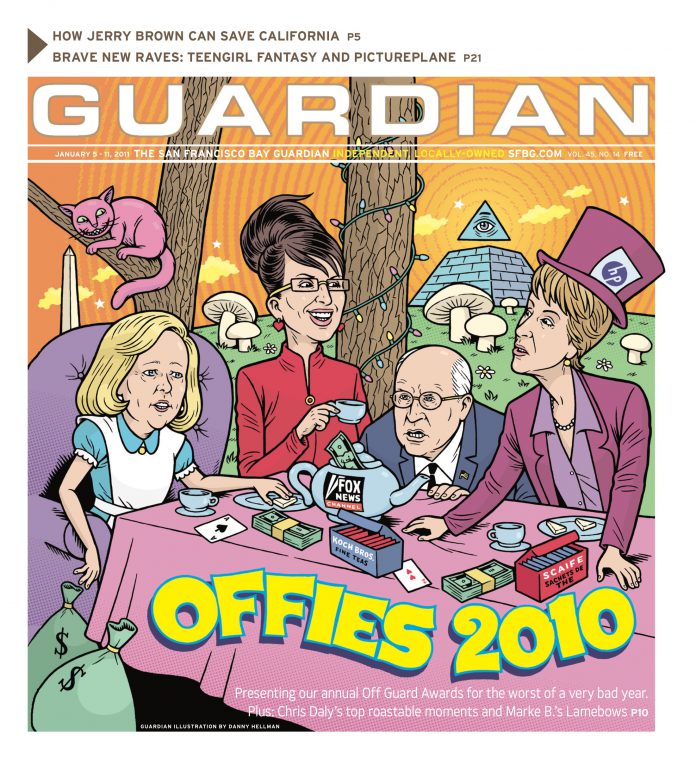arts@sfbg.com
VISUAL ART/MUSIC Suzy Poling greets me by the half-open front gate of Queen’s Nails Projects and hands me a Sapporo tallboy. It’s freezing outside, and not much warmer inside. And dark. But not for long: within moments, she’s turning on a projector at the top of a tall ladder, running tape through a bulky Pioneer tape deck on top of a giant Moog, and spinning transparent mobiles that are suspended from the spaces’ ceiling, all while explaining her thoughts on making art and the ideas behind her current show, “Zone Modules.” Analog sound growls like an electric beast. The big square room expands to an outer space with rough edges, as projector light refracted from glass and mirrors floats like electric stars across a gray-silver moon on one a wall.
“I think I’m into it,” Poling wonders out loud, looking at the wall fixture. “In this exhibition, there’s an overall idea of future decay.” She’s telling the truth, not spinning an artist’s statement, and yet there’s also a current of energy and motion coursing through the room. At a certain point I realize that things are moving all around me, including behind my shoulder, a corner-of-the-eye feeling that is disconcerting and exciting — in terms of immersion, it evokes Bruce McClure’s and Anthony McCall’s explorations of live cinema, or an inverted version of the effects created by Yayoi Kusama’s infinity rooms. “I think people want to get in touch with infinity rooms [right now],” Poling agrees, when I mention Kusama. “It makes sense to get in touch with the planet we’re on and everything around it.”
This is just the beginning of “Zone Modules,” and just a hint of the constantly intersecting sonic and visual energies at play in Poling’s broader art endeavors, a growing and morphing constellation that connects colorfully primordial photos of geysers to layered, artificial experiments in grayscale. We walk to the next room, a small black space with an old black-and-white television in one corner tuned to an eternal 1920s movie dreamscape. “Everyone really liked this room for some reason [at the opening],” Poling says with a shrug, as swirling fog gives way to a close-up of a cut jewel on the small screen. “It’s like hanging out in a black room with a boob tube — it’s a classic hypnosis.”
The relaxed humor and pleasure in this room, though “experiential,” as Poling put it, is not common in today’s art world. It puts me in mind of Cary Loren, a friend of Poling’s from Detroit (and a member of the influential noise band Destroy All Monsters), whose viewpoint possesses a similar enjoyment of pop culture mutation — one that’s not kitschy, but imaginative in a raw, imperfect, individual manner. Poling’s years growing up and exploring the abandoned spaces of Detroit and then Chicago are central to what she’s making today. “It’s so cold and there’s some strange individuals there,” she says affectionately, when I bring up the Midwest. “I drew a lot of my inspiration from the Congress Theatre, this old movie palace from the 1920s on Milwaukee Avenue. I used to live inside it. I started [ the musical project] Pod Blotz there, because I could bring an organ up onto the stage.”
For around a decade, Poling has lived in Oakland, perhaps the closest thing that California has to offer to those kinds of urban autonomous zones. As we move to another room in “Zone Modules” and she talks about a geometric costume she used to wear to early Pod Blotz shows — “I thought, ‘I love theater of Bauhaus, I love Dada, I love the Vienna actionists, and I’m going for this !” — I’m struck by the unashamed enthusiasm for different periods and styles of art, some outre or out of fashion, within her work. To say it’s refreshing in these jaded times would be an understatement. But this isn’t naïve art — it’s gradually formulating a personal vision informed by everything from optics and opthamology to Russian avant-garde posters. “I’m not going to deny these things — I like [Laszlo] Moholy-Nagy!,” Poling exclaims at one point.
“I could reinstall this installation a bazillion different ways and it would always be different,” Poling says, as a characterful projected object darts like a dragonfly around the corner of an adjacent room. Not all artists could make such a claim, and fewer still could say it and have the idea be exciting. Poling credits the endless potential for combinations present in “Zone Modules” to curator Julio Cesar Morales’s insights about what to leave out of the show, but I think it also has something to do with the her experiences collaborating with artists on an international scale, and her kinship with them. Along with her best friend Kamau Patton, she was part of Official Tourist, an artist group that included members from Bosnia and Japan. “I’ll relate to a friend in Belgium in Dolphins into the Future who makes psychedelic spacey new age music,” she says, when talking about the music of Pod Blotz. “But then I also really relate to Haters in Los Angeles. They make totally different kinds of music, but they have a deep respect for each other.”
In the back room of “Zone Modules,” Poling’s paintings — which layer paint over vinyl and and paper to create interruptions in form and shape — share space with geometric sculptural and light experiments. I stare into the triangular eye of a metallic sculpture in the center of the room and through a tetrahedral passageway, spy another trangle, this time painted. “I like having the ability to just go into making art with people,” Poling says. “That feeling that the creation station is out there.”
SUZY POLING: ZONE MODULES
Fri.–Sat., 11 a.m.–6 p.m.
Closing performance with Death Sentence: Panda, Chen Santa Maria
Fri/7, 8–11p.m.
Queen’s Nails Projects
3191 Mission, SF

